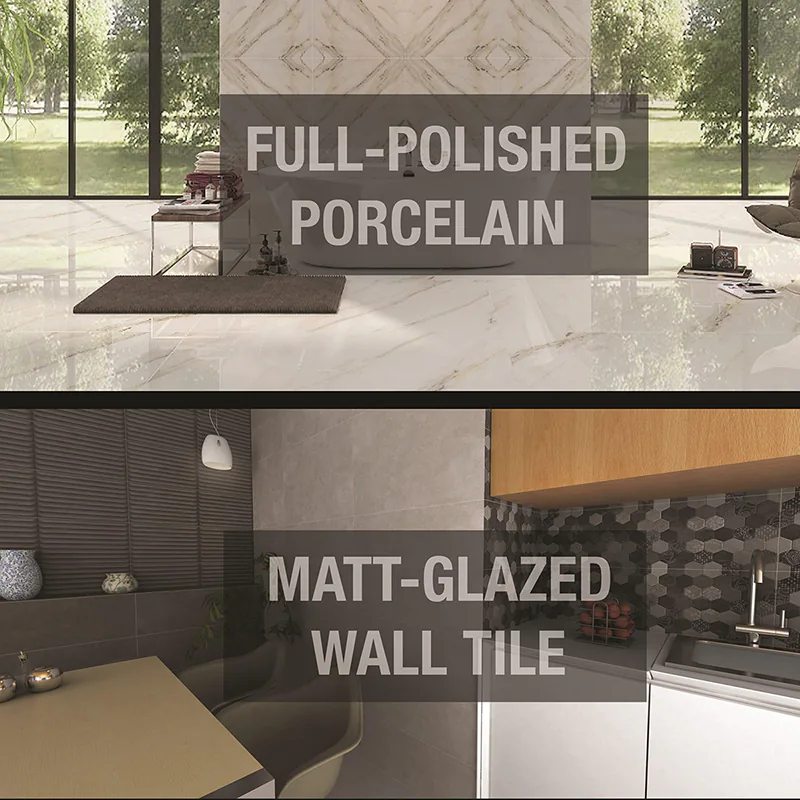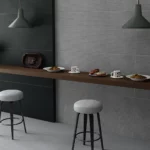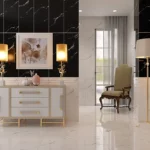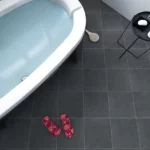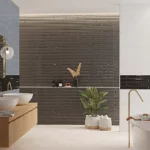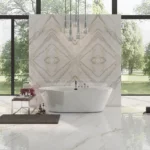Roto color printing: In this printing method, the printing paste containing ceramic pigment is shown on the tile surface by the cylinder on which the design is engraved using the laser system.
Depending on the depth and type of roller or cylinder engraving, the color intensity of the tile may vary. In this method the tile design is laser engraved on the cylinders and then printed on the surface of the tile by cylinder contact.
Digital printing: At present this is the best and most quality way to print on a tile.
The basis of this approach is almost like regular printers, and these printers print the design without touching the surface of the tile. Digital printing is also used for special parts, photo catalytic tiles, photovoltaic tiles and surfaces that cannot be printed in conventional ways. Digital printing requires some basic knowledge of color principles. in all these cases, the basic idea is to reproduce and combine colors.
Rectified tiles: “rectified” in the ceramic tile market is referred to ceramic tiles that it is worked on the edges of the ceramic tiles at the end of the one-step manufacturing process. At this point, a very narrow portion of the ceramic tile edge is cut by devices such as water jets to eliminate the rounded edges of the ceramic which is made due to sliding glaze in order to have sharp and cut edges. then there is no need to have grouting when installing rectified ceramic tiles and that the tiles are precise and bonded.
In addition, rectified ceramic tile is also called “calibrated “.
Matt surface: As matt finishes are less smooth, they give a better grip and have far better traction than gloss tiles. Thus, matt tiles are an ideal choice for flooring – particularly bathroom or wet room floors, or in high traffic areas such as entrance hallways. Outdoor areas are particularly suited for matt tiles due to their better slip resistance.
If you want to create a calming space within your home in which to unwind and relax, then matt – with its soft, muted hues – is the perfect finish. The natural look of matt embodies an authentic, soothing ambience. For similar reasons, matt tiles are the unparalleled choice for those wishing to create a home space with a traditional or rustic look. Matt stone-effect or wood-effect tiles, help to create that gorgeous warm, homely setting. matt glaze will conceal dirt and grime laid down by passing traffic. thus, they don’t require frequent cleaning, However, when matt does need cleaning, it’s harder to remove stains than from glossy finishes. This low maintenance requirement makes matt tiles the obvious choice for busy bathrooms, and ideal for holiday homes where cleaning is far less frequent
Glossy surface:
As glossy tiles bounce light around the room in a reflective, mirror-like fashion they tend to open up small spaces and make rooms appear larger than they actually are. The microscopically smooth finish tricks the eye. Thus, glossy tiles are ideal for use in smaller rooms such as on bathroom walls, in tight kitchens, and even in box rooms.
And as the mirror-like effect allows light to bounce back and forth around the room, glossy tiles are also ideal for use in rooms with limited light as they can make the space appear considerably brighter.
The slippery nature of gloss surfaces means they’re extremely easy to wipe clean. As a result, glossy tiles are ideal for bathroom walls and kitchen splash backs.
A practical location for glossy tiles that many homeowners overlook is around fireplaces. The soot and grime of the fire can be effortlessly removed from the glossy surface – it’s one of the best kept secrets to save you cleaning time in the home. And the use of marble-effect or encaustic-effect glossy tiles will give your fireplace a truly original and authentic feel. However, gloss highlights imperfections such as footprint, fingerprint, soap spears or any stains. It also tends to be more slippery than a matt surface – particularly when wet. Therefore, it’s never a good idea to use a gloss tile for flooring – and particularly for bathroom or wet-room flooring or in high traffic areas such as entrance halls.
Floor tiles:
Floor tiles are thicker and stronger than wall tiles with less water absorption.
Wall tiles:
wall tiles are often lighter and thinner than floor tiles.
The glazes used in the manufacture of a wall tile are also different to those used for floor tiles, and are not designed to resist abrasive forces from foot traffic. They also have more water absorption to stick on the wall.
Porcelain: porcelain tiles are used to cover floors and walls, with a water absorption rate of less than 0.5 percent. The clay used to build porcelain tiles is generally denser. They can either be glazed or unglazed. Porcelain tiles are one type of vitrified tiles, and are sometimes referred to as porcelain vitrified tiles.
Full polished tiles: Polished tiles are exactly what they say on the tin – tiles with a highly polished finish that’s achieved by grinding the surface of the tile with a diamond disk.
When people refer to ‘polished porcelain’ they’re usually referring to a particular type with a relatively plain surface, but there’s actually two different types of polished porcelain tiles. It’s important to note the difference as they’re equally popular:
With unglazed polished tiles the color runs all the way through the thickness of the tile. There’s no glaze as such to wear away, so the end result is an incredibly dense and strong tile.
With glazed polished tiles, a layer of glaze is added to the tile before it goes into the kiln. This makes the tile slightly less durable, but means that the surface can be decorated to imitate natural stones in incredible detail.


